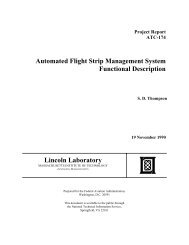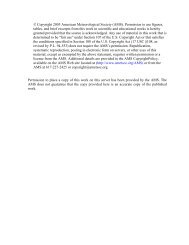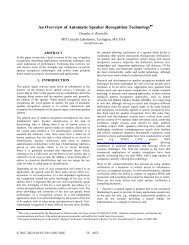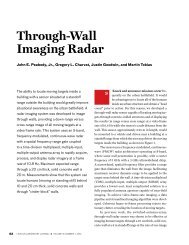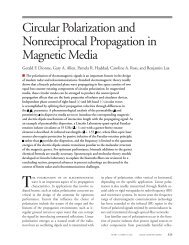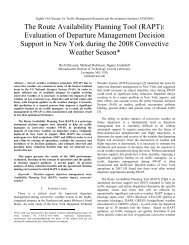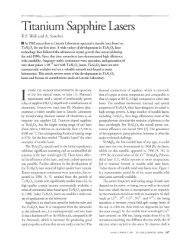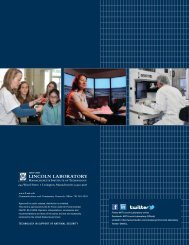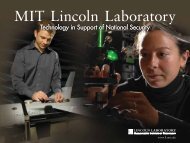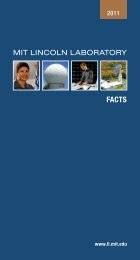Laser Development at Lincoln Laboratory - MIT Lincoln Laboratory
Laser Development at Lincoln Laboratory - MIT Lincoln Laboratory
Laser Development at Lincoln Laboratory - MIT Lincoln Laboratory
You also want an ePaper? Increase the reach of your titles
YUMPU automatically turns print PDFs into web optimized ePapers that Google loves.
• MELNGAILIS<br />
<strong>Laser</strong> <strong>Development</strong> <strong>at</strong> <strong>Lincoln</strong> Labor<strong>at</strong>ory<br />
FIGURE 13. Two microchip lasers in a heterodyne experiment. (Note: The holes on the<br />
work table are 1 inch on center.)<br />
ionic solid st<strong>at</strong>e lasers in 1964 by using a bank ofGaAs<br />
diodes to pwnp a U 3 +:CaF 2 laser rod [52]. However,<br />
extensive employment of this technique did not take<br />
place until two decades l<strong>at</strong>er, when diode lasers had<br />
achieved the adequ<strong>at</strong>e wavelength control, high efficiency,<br />
room-temper<strong>at</strong>ure oper<strong>at</strong>ion, and long lifetimes th<strong>at</strong><br />
made such pwnping advantageous over lamp pumping.<br />
The present effort in this area includes tiny diodepwnped<br />
microchip lasers [53] (Figure 13) for applic<strong>at</strong>ions<br />
as stable narrow-line sources in communic<strong>at</strong>ions and<br />
fiber gyros and as efficient high-power transmitters for<br />
laser radars [54]. As an example ofthe l<strong>at</strong>ter applic<strong>at</strong>ion,<br />
the Solid St<strong>at</strong>e Division has developed a 10-W-averagepower<br />
diode-pwnped Nd:YAG laser th<strong>at</strong> is currently<br />
being used <strong>at</strong> the Firepond site in laser radar experiments<br />
for range measurements and for tracking space objects.<br />
Gas <strong>Laser</strong>s<br />
Applic<strong>at</strong>ions in laser radar and high-precision spectroscopy<br />
have driven most of the gas-laser development <strong>at</strong><br />
<strong>Lincoln</strong> Labor<strong>at</strong>ory. Starting in the mid-1960s, the Optics<br />
Division designed and built sealed-offCO 2 lasers for<br />
ultrastable oper<strong>at</strong>ion in the TEM oo mode for use as local<br />
oscill<strong>at</strong>ors and master oscill<strong>at</strong>ors in coherent 10.6-,um<br />
radars [55, 56]. Single-frequency output powers up to<br />
45 W and a yet-to-be-surpassed short-term frequency<br />
stability oft-.flf$. 1.5 x 10- 13 over 0.1 sec were obtained.<br />
Figure 14 is a photograph of one of the first sealed-off<br />
CO 2 lasers, which was built with four invar rods to<br />
reduce the cavity-length vari<strong>at</strong>ion with temper<strong>at</strong>ure. To<br />
achieve absolute frequency stabiliz<strong>at</strong>ion, a technique<br />
th<strong>at</strong> makes use of s<strong>at</strong>ur<strong>at</strong>ion resonance on the 4.3-,um<br />
wavelength fluorescence ofCO 2 was invented [57]. The<br />
technique enables absolute frequency reproducibilities<br />
to within 3 kHz in nine CO 2 isotopic species. Thus<br />
secondary frequency standards in the 8.9-to-12.3-,um<br />
wavelength range could be cre<strong>at</strong>ed with the Cs <strong>at</strong>omic<br />
clock used as a primary standard.<br />
For applic<strong>at</strong>ions in compact imaging radars, a modified<br />
ultrastable CO 2 laser th<strong>at</strong> can be oper<strong>at</strong>ed either in<br />
a CWor electronically Q-switched mode was built [58].<br />
Mini<strong>at</strong>ure transverse-electric <strong>at</strong>mospheric-pressure lasers<br />
with 10-W average powers (20 m] <strong>at</strong> 500 Hz) were designed<br />
and built for lidar measurement of <strong>at</strong>mospheric<br />
constituents [59]. In 1970 <strong>Lincoln</strong> Labor<strong>at</strong>ory was also<br />
the first to achieve the sealed-offoper<strong>at</strong>ion ofCO lasers,<br />
VOLUME 3. NUMBER 3. 1990 THE LINCOLN LABORATORY JOURNAL 355




